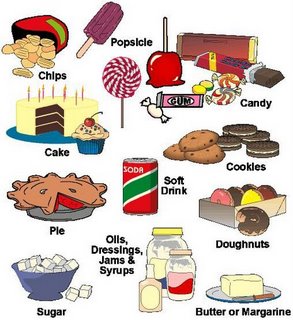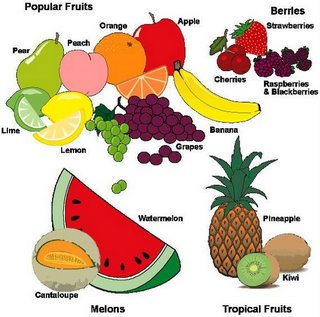Food Pyramid.
For good helt, eat a lot of grains, vegetables, and fruit. Eat some dairy, meat, and other protein. Eat very little fat, oil, and sugar.
This link is the "U.S. Department of Agriculture.": USDA
- Food & Nutrition Item, here.
What foods are in the grain group?

Any food made from wheat, rice, oats, cornmeal, barley or another cereal grain is a grain product. Bread, pasta, oatmeal, breakfast cereals, tortillas, and grits are examples of grain products.
Some commonly eaten grain products are:
Whole grains:
brown rice
buckwheat
bulgur (cracked wheat)
oatmeal
popcorn
Ready-to-eat breakfast cereals:
whole wheat cereal flakes
muesli
whole grain barley
whole grain cornmeal
whole rye
whole wheat bread
whole wheat crackers
whole wheat pasta
whole wheat sandwich buns and rolls
whole wheat tortillas
wild rice
Less common whole grains:
amaranth
millet
quinoa
sorghum
triticale
Refined grains:
cornbread*
corn tortillas*
couscous*
crackers*
flour tortillas*
grits
noodles*
Pasta*
spaghetti
macaroni
pitas*
pretzels
Ready-to-eat breakfast cereals:
corn flakes
white bread
white sandwich buns and rolls
white rice.
*********************************
*Most of these products are made from refined grains. Some are made from whole grains. Check the ingredient list for the words “whole grain” or “whole wheat” to decide if they are made from a whole grain. Some foods are made from a mixture of whole and refined grains.
Some grain products contain significant amounts of bran. Bran provides fiber, which is important for health. However, products with added bran or bran alone (e.g., oat bran) are not necessarily whole grain products.
What are “oils”?

Oils are fats that are liquid at room temperature, like the vegetable oils used in cooking. Oils come from many different plants and from fish.
- canola oil
corn oil
cottonseed oil
olive oil
safflower oil
soybean oil
sunflower oil
Some oils are used mainly as flavorings, such as walnut oil and sesame oil. A number of foods are naturally high in oils, like:
- nuts
olives
some fish
avocados
Foods that are mainly oil include mayonnaise, certain salad dressings, and soft (tub or squeeze) margarine with no trans fats. Check the Nutrition Facts label to find margarines with 0 grams of trans fat. Amounts of trans fat will be required on labels as of 2006. Many products already provide this information.
Most oils are high in monounsaturated or polyunsaturated fats, and low in saturated fats. Oils from plant sources (vegetable and nut oils) do not contain any cholesterol. In fact, no foods from plants sources contain cholesterol.
A few plant oils, however, including coconut oil and palm kernel oil, are high in saturated fats and for nutritional purposes should be considered to be solid fats.
Solid fats are fats that are solid at room temperature, like butter and shortening. Solid fats come from many animal foods and can be made from vegetable oils through a process called hydrogenation.
Some common solid fats are:
- butter
beef fat (tallow, suet)
chicken fat
pork fat (lard)
stick margarine
shortening
What foods are in the fruit group?

Any fruit or 100% fruit juice counts as part of the fruit group. Fruits may be fresh, canned, frozen, or dried, and may be whole, cut-up, or pureed.
Some commonly eaten fruits are:
Apples
Apricots
Avocado
Bananas
Berries:
strawberries
blueberries
raspberries
cherries
Grapefruit
Grapes
Kiwi fruit
Lemons
Limes
Mangoes
Melons:
cantaloupe
honeydew
watermelon
Mixed fruits:
fruit cocktail
Nectarines
Oranges
Peaches
Pears
Papaya
Pineapple
Plums
Prunes
Raisins
Tangerines
100% Fruit juice:
orange
apple
grape
grapefruit
What foods are in the vegetable group?
Any vegetable or 100% vegetable juice counts as a member of the vegetable group. Vegetables may be raw or cooked; fresh, frozen, canned, or dried/dehydrated; and may be whole, cut-up, or mashed.
Vegetables are organized into 5 subgroups, based on their nutrient content. Some commonly eaten vegetables in each subgroup are:
Dark green vegetables:
bok choy
broccoli
collard greens
dark green leafy lettuce
kale
mesclun
mustard greens
romaine lettuce
spinach
turnip greens
watercress
Orange vegetables:
acorn squash
butternut squash
carrots
hubbard squash
pumpkin
sweetpotatoes
Dry beans and peas:
black beans
black-eyed peas
garbanzo beans (chickpeas)
kidney beans
lentils
lima beans (mature)
navy beans
pinto beans
soy beans
split peas
tofu (bean curd made from soybeans)
white beans
Starchy vegetables:
corn
green peas
lima beans (green)
potatoes
Other vegetables:
artichokes
asparagus
bean sprouts
beets
Brussels sprouts
cabbage
cauliflower
celery
cucumbers
eggplant
green beans
green or red peppers
iceberg (head) lettuce
mushrooms
okra
onions
parsnips
tomatoes
tomato juice
vegetable juice
turnips
wax beans
zucchini
What foods are included in the meat, poultry, fish, dry beans, eggs, and nuts (meat & beans) group?

All foods made from meat, poultry, fish, dry beans or peas, eggs, nuts, and seeds are considered part of this group. Dry beans and peas are part of this group as well as the vegetable group. For more information on dry beans and peas click here.
Most meat and poultry choices should be lean or low-fat. Fish, nuts, and seeds contain healthy oils, so choose these foods frequently instead of meat or poultry. (See Why is it important to include fish, nuts, and seeds?)
Some commonly eaten choices in the Meat and Beans group, with selection tips, are:
Meats*
Lean cuts of:
Game meats:
bison
rabbit
venison
Lean ground meats:
beef
pork
lamb
Lean luncheon meats
Organ meats:
liver
giblets
Poultry*
chicken
duck
goose
turkey
ground chicken and turkey
Eggs*
chicken eggs
duck eggs
Dry beans and peas:
black beans
black-eyed peas
chickpeas (garbanzo beans)
falafel
kidney beans
lentils
lima beans (mature)
navy beans
pinto beans
soy beans
split peas
tofu (bean curd made from soy beans)
white beans
bean burgers:
garden burgers
veggie burgers
tempeh
texturized vegetable protein (TVP)
Nuts & seeds*
almonds
cashews
hazelnuts (filberts)
mixed nuts
peanuts
peanut butter
pecans
pistachios
pumpkin seeds
sesame seeds
sunflower seeds
walnuts
Fish*
Finfish such as:
catfish
cod
flounder
haddock
halibut
herring
mackerel
pollock
porgy
salmon
sea bass
snapper
swordfish
trout
tuna
Shellfish such as:
clams
crab
crayfish
lobster
mussels
octopus
oysters
scallops
squid (calamari)
shrimp
Canned fish such as:
anchovies
clams
tuna
sardines
********************************
*Selection Tips
Choose lean or low-fat meat and poultry. If higher fat choices are made, such as regular ground beef (75 to 80% lean) or chicken with skin, the fat in the product counts as part of the discretionary calorie allowance. Click here for more details on discretionary calories.
If solid fat is added in cooking, such as frying chicken in shortening or frying eggs in butter or stick margarine, this also counts as part of the discretionary calorie allowance. Click here for more details on discretionary calories.
Select fish rich in omega-3 fatty acids, such as salmon, trout, and herring, more often (See Why is it important to include fish, nuts, and seeds?).
Liver and other organ meats are high in cholesterol. Egg yolks are also high in cholesterol, but egg whites are cholesterol-free.
Processed meats such as ham, sausage, frankfurters, and luncheon or deli meats have added sodium. Check the ingredient and Nutrition Facts label to help limit sodium intake. Fresh chicken, turkey, and pork that have been enhanced with a salt-containing solution also have added sodium. Check the product label for statements such as “self-basting” or “contains up to __% of __”, which mean that a sodium-containing solution has been added to the product.
Sunflower seeds, almonds, and hazelnuts (filberts) are the richest sources of vitamin E in this food group. To help meet vitamin E recommendations, make these your nut and seed choices more often.












